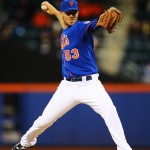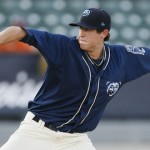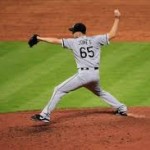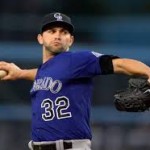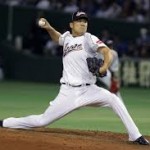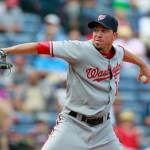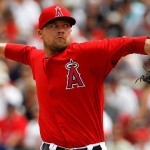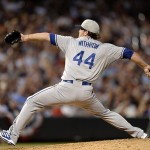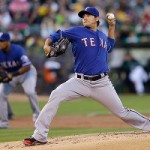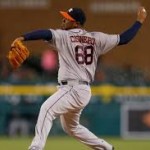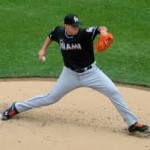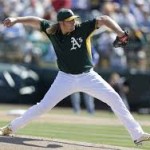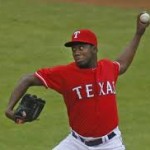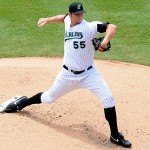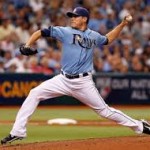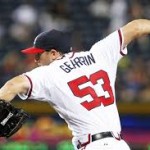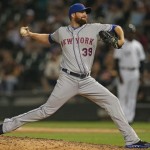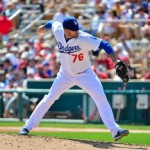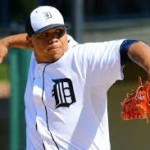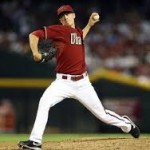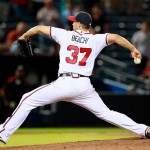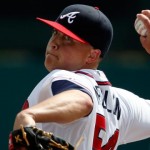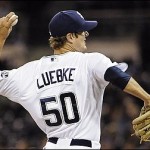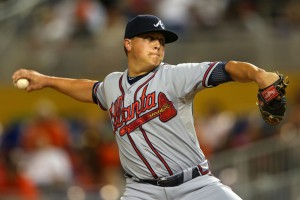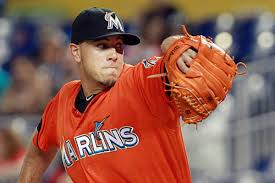
Jose Fernandez was (arguably) the biggest name to go down to TJ surgery in 2014. Photo via thestar.com
When we hit 20 MLB pitchers going under the knife for blown Ulnar Collateral Ligaments (UCL) on the 2014 season, I posted on possible reasons for the epidemic. By the time the season was over, more than 90 players in professional baseball (and a handful of marquee amateurs, including two first round picks and our own) had gone under the knife for blown UCLs/Tommy John surgery. 2014 was the year of the elbow ligament, no question, in terms of volume and awareness.
This post lists all the major league pitchers who had the surgery this year, with links to the announcements as they happened, along with stills of the pitchers’ mechanics to do a quickie thumb nail analysis of mechanics and whether there’s a relationship to the injury. At the bottom i’ve captured any significant news related to the surgery, MLB being proactive in preventing the injuries, and other TJ news.
First, here’s the complete Tommy John fall-out for the year for major league arms. According to the great injury tracking links below, no less than 91 players in all levels of pro baseball had the surgery in calendar year 2014, of which 29 were MLB-experienced pitchers.
(data from baseballheatmaps.com, which has detailed Disabled List data).
- Jonny Venters, recovering from his 2nd TJ surgery, re-tore the ligament and is going for his THIRD.
- Jeremy Hefner, already on the shelf from a TJ surgery *last* year, suffered a big set-back and may have to have a 2nd procedure (announced 8/11/14)
- Tyler Skaggs was diagnosed on 8/10/14 with needing the surgery.
- Nate Jones: diagnosed 7/31/14.
- Tyler Chatwood: diagnosed 7/17/14
- Masahiro Tanaka, diagnosed with torn UCL 7/10/14; a huge blow, nearly as big of an announcement as Jose Fernandez’ if he has to get TJ surgery. No announcement yet though that he’s having the surgery. But, as of 8/5/14 he’s re-habbing and experiencing no pain while throwing, and eventually was able to avoid the surgery. For now.
- Bronson Arroyo diagnosed 7/8/14, a surprise considering his durability and soft-tossing nature.
- Trevor Bell, diagnosed 4/23/14 but finally getting the surgery 7/16/14.
- (… we go more than a month without another diagnosis after getting them nearly daily in April and May. Odd).
- Sean Burnett: diagnosed 5/28/14 (would be his 2nd)
- Chris Withrow: diagnosed 5/29/14 (though technically he’d been optioned to AAA; not sure if this should count as a MLBer)
- Martin Perez: diagnosed 5/15/14
- Jose Cisnero: diagnosed 5/14/14.
- Jose Fernandez: diagnosed 5/13/14. Wow, biggest name to fall yet.
- AJ Griffin: getting the surgery 4/27/14
- Pedro Figueroa: diagnosed 4/24/14 (his 2nd, first in 2010)
- Ivan Nova: diagnosed 4/25/14
- Josh Johnson: diagnosed/announced 4/23/14, surgery 4/24/14. His 2nd (first in 2007).
- Matt Moore: surgery 4/22/14
- Cory Gearrin: diagnosed 4/8/14
- Bobby Parnell: diagnosed 4/2/14
- Erik Davis: diagnosed 4/2/14
- David Hernandez: diagnosed 3/31/14
- Peter Moylan: diagnosed 3/22/14 (his 2nd)
- Bruce Rondon: diagnosed 3/21/14
- Patrick Corbin: diagnosed 3/17/14
- Jarrod Parker: diagnosed 3/17/14. (his 2nd)
- Brandon Beachy: diagnosed 3/17/14 (his 2nd)
- Kris Medlen: diagnosed 3/9/14. (his 2nd)
- Luke Hochevar: announced 3/7/14
- Cory Luebke: surgery in 2/4/14 (his 2nd)
10 of these 29 pitchers are getting the surgery for the 2nd time. Wow.
Here’s links to other notable non-MLB pitchers who have gotten the surgery as well in 2014:
- Jamison Taillon: the Pirates #1 pitching prospect and one of the best pitching prospects in the game. Diagnosed 4/6/14, surgery 4/9/14.
- Danny Rosenbaum: Nats AAA starter and long-time farmhand. Surgery 5/8/14. Tough for Rosenbaum because he’s a MLFA this coming off-season, now facing a very uncertain future.
- Miguel Sano: one of the best prospects in the minors, had the surgery 3/12/14. He’s not a pitcher, and he initially injured his arm playing in the Dominican Winter League, but it still costs Minnesota one of its best prospects.
- Jeff Hoffman, ECU’s right handed starter and consensus top 5 pick in the 2014 draft, hurt his arm and was diagnosed on 5/8/14. He dropped 5 places from his likely drafting spot by the Cubs at #4, which cost him about $X in slot dollars. We talked about whether the Nats (picking at #18) were a likely suitor for him at the time of the injury in early May.
- Erick Fedde, UNLV’s friday starter and projected mid-1st round pick, was diagnosed two days after Hoffman on 5/10/14. He dropped perhaps 8 places from his estimated drafting spot of mid 1st round and was picked by Washington. His injury didn’t really cost him much in slot money thanks to the Nats paying over-slot.
- Our own Matthew Purke, diagnosed and set for TJ surgery 5/29/14 after really struggling out of the gate this year for Harrisburg. Purke may face an options crunch by the time he’s done re-habbing, thanks to his MLB deal signed on draft-day. (Update: the Nats never let him get there, releasing him on 11/14/14).
- Chad Billingsley having flexor tendon surgery while trying to recover from his 2013 TJ surgery. This isn’t counted as a TJ, but is noteworthy.
- Not a pitcher, but key Orioles player Matt Wieters had to have TJ surgery on 6/18/14.
- Matt Cain dodged a bullet by just being diagnosed with elbow chips, but still had season-ending elbow surgery on 8/5/14.
- Padres uber-prospect and 2012 first rounder Max Fried went under the knife in mid-august.
- Yu Darvish didn’t fall victim to the TJ surgery, but an elbow issue is shutting him down in late August, just the latest nail in the coffin of the Rangers’ season.
- Jonathan Mayo discussion on elbow surgeries and prospects from Mid-Late August.
Here’s quickie images of every MLB starter diagnosed this year as they land to make a quick judgement about their mechanics:
Quick and Dirty Mechanics analysis (images in same order as list of pitchers above, which is chronological in order of diagnosis in 2014):
- Inverted W: Hefner, Skaggs, Withrow, Griffin, Nova, Gearrin, Beachy, Hochevar
- Sideways M: Ventors, Chatwood, Bell, Burnett, Fernandez, Johnson, Davis, Moylan, Rondon, Parker, Medlen
- Inverted L: Jones, Tanaka, Arroyo, Perez, Cisnero, Figueroa, Moore, Parnell, Hernandez, Corbin, Luebke
Conclusions? None. They’re all over the road. TJ injuries this year happened to those thought to have “dangerous” mechanics and clean mechanics. TJ injuries happened to the league’s harder throwers (Rondon, Ventors, Fernandez) and its softest throwers (Medlen and Arroyo, both of whom are usually at the absolute bottom of the league in terms of fastball velocity). Starters and relievers, no discernable pattern.
I think all you can conclude is this: if you throw a lot of innings, you’re more prone to injury. I know, ground breaking analysis.
Other notable/interesting links I’ve collected on the topic over the length of the season:
- Yahoo’s Tim Brown interviewed Zack Greinke (published 5/15/14)who says he made a conscious decision to throw fewer sliders, noting that he could really feel it in his elbow after starts where he threw too many. This tends to support the notion that sliders make a difference.
- Jerry Crasnick interviewed commissioner Bud Selig on 5/15/14 and Selig said he’s “concerned.” Great! On a scale of “Resolve Oakland/San Jose territorial rights” concerned to “Resolve MASN dispute” concerned, I wonder where he falls? Maybe he’ll form a blue-ribbon committee that can meet for several years without arriving at any solutions.
- Stephania Bell‘s articles on the spate of TJ injuries: from April and again in May.
- Nate Silver‘s new blog 538 chimes in in mid-may.
- Neil Weinberg from Peter Gammons‘ website posts his own theory on 5/16/14 that is basically related to the rise in youth/showcase events.
- Shawn Anderson from the blog HallofVeryGood.com posts his theory (overuse).
- An older link to Will Carrol from July 2013 talking about the surgery, how its done, who’s had it and some other great stuff.
- The American Sports Medicine Institute (led by Dr. James Andrews) released a statement on 5/28/14 on the issue of Tommy John surgeries (as pointed out by David Schoenfield and/or Craig Calcaterra in late may and/or Jerry Crasnick on the same day). Their basic point: don’t throw with max effort.
- Dr. James Andrews announced that he’s releasing an app to help keep pitchers healthy. Per screen shots, it will be relatively simple and will have pitch counts, age and rest days calculate a max number of pitchers that a player can throw today.
- An interesting analysis of Kansas City’s Yordano Ventura after he was diagnosed with a non-UCL related elbow injury in May.
- Thoughtful piece from Dirk Hayhurst about the quest for velocity and the value of soft-throwers like Mark Buehrle.
- Danny Knobler special piece to the BleacherReport in June 2014 discussing “child abuse” of kids over-throwing, throwing too much, too hard, too soon.
- A sleeve has been announced that may help prevent TJ injuries (its called the Motus Pitcher Sleeve). Dirk Hayhurst subsequently did some research and interviews about the sleeve and offers some thoughts.
- CBS’s Jon Heyman breaks the news that #1 overall pick Brady Aiken may have an “elbow ligament issue,” thus holding up the signing. Wow. As we all know, this turned into a big-time stalemate, the non-signing of Aiken (which cascaded down and cost the Astros their 5th round pick too), possible grievances, possible lawsuits, all sorts of NCAA eligibility concerns, and a whole big black-mark for the Astros organization. All over $1.5M. Remember; this is the same team that gave $30M last off-season to 5th starter Scott Feldman.
- There was a two hour special on the injury on MLB Radio Networks on 7/17/14 that I hope they replay or transcribe to the internet.
- Bud Selig still awaits the Tommy John study in Mid July 2014. If its anything like his other blue-ribbon panels, he’ll be waiting a long time.
- Discussion about youths with UCL/TJ injuries in USA Today on 7/23/14.
- Study from USA Today on how prep pitchers are avoiding TJ.
- MLB unveils “Pitch Smart” guide in Mid November to help youth’s understand workloads. Also discussed by Jeff Passan.
Hope you’ve found this trove of TJ links as interesting as I have.

